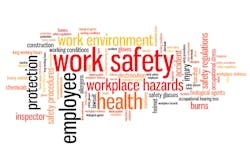Unsafe Conditions Around De-Energized Equipment, Part 1
While lockout/tagout removes a major safety hazard, it doesn’t automatically establish a safe work condition. Even if equipment has never been energized, you can have an unsafe work condition.
For example, it’s a green construction office project and you’re running the electrical metallic tubing (EMT) to each room for the receptacle boxes you’re also installing. Drywallers are working practically on top of you and there’s another crew installing the lights overhead. Needless to say, it’s crowded, and you have many tripping hazards, such as buckets of drywall compound, extension cords, tools, ladders, and various materials.
You have an unsafe working condition just because of the crowding and parallel projects. Dangers can be reduced in multiple ways. For example, designate one room for storing tools and materials instead of having them spread everywhere. Run extension cords along walls and tape them in place. Coordinate with other crews so you aren’t working on top of each other.
About the Author

Mark Lamendola
Mark is an expert in maintenance management, having racked up an impressive track record during his time working in the field. He also has extensive knowledge of, and practical expertise with, the National Electrical Code (NEC). Through his consulting business, he provides articles and training materials on electrical topics, specializing in making difficult subjects easy to understand and focusing on the practical aspects of electrical work.
Prior to starting his own business, Mark served as the Technical Editor on EC&M for six years, worked three years in nuclear maintenance, six years as a contract project engineer/project manager, three years as a systems engineer, and three years in plant maintenance management.
Mark earned an AAS degree from Rock Valley College, a BSEET from Columbia Pacific University, and an MBA from Lake Erie College. He’s also completed several related certifications over the years and even was formerly licensed as a Master Electrician. He is a Senior Member of the IEEE and past Chairman of the Kansas City Chapters of both the IEEE and the IEEE Computer Society. Mark also served as the program director for, a board member of, and webmaster of, the Midwest Chapter of the 7x24 Exchange. He has also held memberships with the following organizations: NETA, NFPA, International Association of Webmasters, and Institute of Certified Professional Managers.
